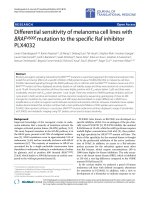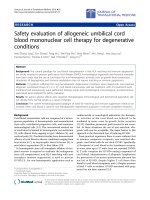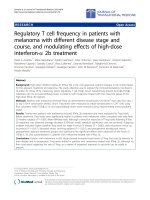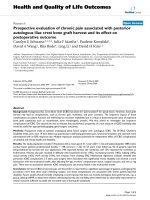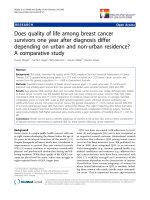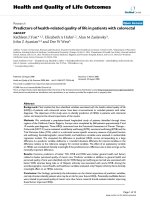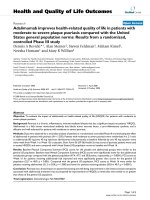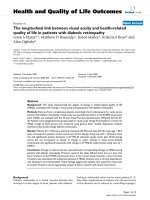báo cáo hóa học:" Health-related quality of life in patients with severe COPD hospitalized for exacerbations - comparing EQ-5D, SF-12 and SGRQ" potx
Bạn đang xem bản rút gọn của tài liệu. Xem và tải ngay bản đầy đủ của tài liệu tại đây (599.32 KB, 9 trang )
Menn et al. Health and Quality of Life Outcomes 2010, 8:39
/>Open Access
RESEARCH
BioMed Central
© 2010 Menn et al; licensee BioMed Central Ltd. This is an Open Access article distributed under the terms of the Creative Commons
Attribution License ( which permits unrestricted use, distribution, and reproduction in
any medium, provided the original work is properly cited.
Research
Health-related quality of life in patients with severe
COPD hospitalized for exacerbations - comparing
EQ-5D, SF-12 and SGRQ
Petra Menn*
1
, Norbert Weber
2
and Rolf Holle
1
Abstract
Background: The aim of this study was to measure HrQoL during acute exacerbations of COPD using generic and
disease-specific instruments, and to assess completeness, proportion with best or worst health state, sensitivity to
change and discriminative ability for each instrument.
Methods: EQ-5D, SF-12 and SGRQ were obtained from COPD patients with GOLD stage III and IV hospitalized for an
acute exacerbation both at admission and discharge. To assess the instruments' properties, utility values were
calculated for EQ-5D and SF-12, and a total score was derived from the SGRQ.
Results: Mean utilities ranged from 0.54 (SF-12, stage IV) to 0.62 (EQ-5D, stage III) at admission, and from 0.58 (SF-12,
stage IV) to 0.84 (EQ-5D, stage III) at discharge. Completeness was best for EQ-5D and SGRQ, while no utility value for
the SF-12 could be calculated for more than 30%. For SGRQ subscales, the minimal score occurred in up to 11% at
admission, while full health was observed for the EQ-5D at discharge in 13%. Sensitivity to change was generally good,
whereas discrimination between COPD stages was low for the EQ-5D.
Conclusions: Acute exacerbations seriously impair health status and quality of life. The EQ-5D is generally suitable to
measure HrQoL in exacerbations of severe COPD, although the high proportion of patients reporting full health at
discharge poses a problem. The main issue with the SF-12 is the high proportion of missing values in a self-assessed
setting. Properties of the SGRQ were satisfactory. However, since no utility values can be derived from this disease-
specific instrument, it is not suitable for cost-utility analyses in health-economic evaluations.
Background
Chronic obstructive pulmonary disease (COPD) is a
common chronic condition that severely affects patients'
health-related quality of life (HrQoL). With a prevalence
of more than 13% in those aged 40 years and older in Ger-
many, COPD is one of the most frequent causes of mor-
bidity and mortality [1]. Exacerbations, acute worsenings
of symptoms, have serious health consequences and are
associated with an increased decline in lung function,
hospitalization and even death [2]. It has been shown that
on average, patients with severe or very severe COPD
experience about 2.7 exacerbations per year, more than
10% of which require hospitalization [3].
A number of studies measure HrQoL in patients with
COPD during stable phases of the disease using e.g. the
generic EuroQol 5 dimension (EQ-5D) [4,5], the Short
Form 12 (SF-12) [6], or the disease-specific St George's
Respiratory Questionnaire (SGRQ) [4,7], but only few
examine the effect of acute exacerbations. For stable dis-
ease, the EQ-5D's ability to discriminate between GOLD
stages has been shown [4], but ceiling effects have also
been reported [4,8]. However, properties of this instru-
ment have not been assessed for acute exacerbations.
The most frequently used instruments to measure
HrQoL during acute exacerbations are the SGRQ [9,10]
and the Chronic Respiratory Disease Questionnaire
(CRQ) [10,11]. As disease-specific instruments such as
the SGRQ do not capture aspects of HrQoL unrelated to
the specific disease and its consequences, utility values
based on the SGRQ can not be compared with those
* Correspondence:
1
Helmholtz Zentrum München - German Research Center for Environmental
Health, Institute of Health Economics and Health Care Management,
Neuherberg, Germany
Full list of author information is available at the end of the article
Menn et al. Health and Quality of Life Outcomes 2010, 8:39
/>Page 2 of 9
based on generic instruments. To calculate quality-
adjusted life-years (QALYs) for health-economic evalua-
tions, only utilities based on generic instruments should
be used. Utility values for exacerbated COPD based on
generic instruments are essential when the cost-effective-
ness of interventions is to be assessed that reduce the fre-
quency or severity of exacerbations in COPD. To date,
there is only one study that employs the EQ-5D for this
question [12]. Yet it is not clear whether instruments such
as the EQ-5D or the SF-12 are suitable to measure the
impact of exacerbations on HrQoL.
Therefore, the aim of this study was to evaluate HrQoL
using the two generic instruments EQ-5D and SF-12 and
the disease-specific SGRQ in patients with severe and
very severe COPD hospitalized for exacerbations, and to
compare their results with regard to completeness, pro-
portion with best and worst health state, sensitivity to
change and discrimination between groups of different
disease severity.
Methods
Study design
This prospective, observational study was conducted at
the Asklepios Clinics in Gauting, Germany. Inclusion cri-
teria were a minimum age of 45, a prior diagnosis of
COPD and sufficient knowledge of the German language.
All patients admitted between October 2007 and May
2008 for an exacerbation of COPD who met the inclusion
criteria were asked to participate in the study. Partici-
pants signed a written consent form and answered a self-
administered questionnaire within three days after
admission and again within three days of discharge. Tak-
ing additional measurements during the hospital stay was
not feasible for logistic reasons, nor was contacting
patients after discharge for a follow-up. The question-
naire comprised the validated German versions of the
EQ-5D, the SF-12 and the SGRQ to measure HrQoL as
well as questions on patient's sex, age and smoking status.
To assess disease severity, lung function was measured at
discharge and categorized according to the GOLD classi-
fication [13]: Patients with a forced expiratory volume in
1 sec (FEV
1
) of 30-50% of their predicted value were cate-
gorized into stage III, patients with a FEV
1
below 30%
predicted, or with 30-50% predicted and chronic respira-
tory failure were categorized into stage IV. Patients with a
FEV
1
of more than 50% predicted were excluded. Patients
who were readmitted to hospital during the study were
asked to participate again.
Instruments
EQ-5D
The EQ-5D is a generic questionnaire that consists of two
parts: the descriptive section comprises the 5 dimensions
mobility, self-care, usual activities, pain/discomfort and
anxiety/depression [14]. Each dimension has 3 levels: no
problems, some problems and severe problems. Respon-
dents are asked to choose the appropriate level for each of
the five dimensions. Utility scores can then be obtained
by weighting the answers according to a weighting
scheme. For base analysis, the German tariff was used to
calculate utility scores [15]. Rutten-van Mölken et al.
showed for the EQ-5D that utilities differ significantly
depending on the value set used [4]. Thus, in addition to
the German TTO weights, we also calculated utilities
based on the UK tariff according to Dolan [16] to com-
pare our results with studies from other countries.
The second part of the EQ-5D is a visual analogue scale
(VAS). Respondents value their HrQoL on a rating scale
from 0 (worst imaginable health state) to 100 (best imag-
inable health state).
SF-12
The SF-12 is also a generic instrument, containing 12
items selected from the SF-36. A physical and a mental
component score (PCS and MCS) can be calculated. The
PCS ranges from 11 to 60, the MCS from 16 to 70, with
higher values indicating higher HrQoL. As no German
value set was available for the SF-12, an international
value set was used to obtain a preference-based health
index (SF-6D) [17].
SGRQ
The SGRQ is a disease-specific instrument that consists
of 50 items and was specifically developed for patients
with chronic airflow limitation. Three component scores
for the domains symptoms, activity and impact on daily
life can be calculated as well as a total score [18]. Scores
range from 100 to 0, with higher values indicating lower
HrQoL. In contrast to the EQ-5D and the SF-12, no util-
ity index can be obtained from this disease-specific
instrument. For the analyses, the total score was used
instead to assess the SGRQ's properties.
Statistical analysis
Differences between baseline characteristics were tested
using t-tests for continuous variables, and Pearson χ
2
tests
for differences in percentages.
Completeness, proportion with best or worst health
state, sensitivity to change and discrimination between
the disease stages III and IV were considered to compare
the instruments' applicability for COPD patients during
acute exacerbations.
An instrument was considered complete if a utility or
total score could be calculated. For this, in the EQ-5D, all
5 questions needed to be answered. For the SF-12, the
items necessary for the calculation of the SF-6D were
required. To calculate the SGRQ total score, the sub-
scores symptoms, activity and impact had to be available.
On each subscore, 2 to 6 missing items were allowed.
Menn et al. Health and Quality of Life Outcomes 2010, 8:39
/>Page 3 of 9
For each instrument, the proportion of patients with
the best or worst possible health state was reported.
To assess sensitivity to change, standardized differences
(sdiff ) were calculated for the utility and total scores,
respectively [19]. For this, absolute differences between
mean values at discharge ( ) and at admission ( )
were divided by the standard deviation of admission val-
ues (sd
A
): . Paired t-tests were
conducted to check significance on a 5% level. These
analyses were repeated using the non-parametric Wil-
coxon signed rank test for paired comparisons of clus-
tered data as described by Rosner et al. [20] to account for
the non-normality of the variables and the clustered data
structure due to multiple hospital admissions of some
patients.
The ability of an instrument to discriminate between
disease stages was analyzed using linear mixed regression
models, adjusting for age, sex, smoking status and time of
assessment (admission or discharge). Random effects
were employed to account for cluster effects due to multi-
ple admissions. Analyses were rerun univariately using
the non-parametric Wilcoxon rank test for clustered data
[21] for those outcome variables where the assumption of
a normal distribution was rejected, and conclusions were
compared with those based on the parametric regression
models.
Results
Patients
A total of 117 patients with GOLD stages III and IV par-
ticipated in the study. Patient characteristics by disease
stage are shown in Table 1. A total of 71% of patients had
stage IV disease. Patients' age ranged from 45 to 88. Dis-
ease stages were comparable with respect to age, sex,
smoking status and proportion with more than one
admission, but differed significantly in length of stay, with
longer stays for those in stage IV. In all, 8 patients were
observed twice and 1 patient was observed three times.
Therefore, the 117 patients represent 127 admissions.
Health-related quality of life
Table 2 summarizes the distribution of the EQ-5D and
SF-6D results. For the EQ-5D, the most frequent category
at admission was 'some problems' on all dimensions. At
discharge, this changed to 'no problems' for the dimen-
sions self care and anxiety/depression. For the SF-6D
dimensions physical functioning and role limitation, the
worst category was most frequent at both time points,
but improved from level 4 to level 3 for the dimensions
social functioning and mental health from admission to
discharge.
Mean (sd) values for HrQoL at admission and discharge
by disease severity are shown in Table 3. For all instru-
ments, HrQoL improved from admission to discharge,
and apart from the SGRQ symptoms score it was better
in stage III than in stage IV. However, the size of this
effect differed between the instruments: while for the
EQ-5D, differences between disease stages were small,
values increased considerably from admission to dis-
charge. The SF-6D on the other hand improved only
slightly with time, yet stage III patients showed consis-
tently better HrQoL than stage IV patients. Correlations
between EQ-5D and SF-6D were 0.43, between EQ-5D
and SGRQ total -0.59, and between SF-6D and SGRQ
total -0.57.
For comparison with studies from other countries, an
EQ-5D index based on the UK tariff according to Dolan
[16] was calculated additionally. Mean (SD) values for the
UK index of the EQ-5D at admission were 0.46 (0.31) in
stage III and 0.44 (0.31) in stage IV, and at discharge 0.72
(0.23) and 0.61 (0.28), respectively. This difference
between the German and the UK values is due to differ-
ing regression equations in calculating the utilities, where
the German tariff assigns higher values to the same
health states [15].
x
D
x
A
stdiff x x sd
DA A
=−
Table 1: Patient characteristics by disease stage for first admissions
Characteristics Stage III
(n = 34)
Stage IV
(n = 83)
p-value
age (mean (sd)) 67 (8) 68 (8) 0.77*
male (%) 59 66 0.53
†
current smoker (%) 18 14 0.78
†
> 1 admission (%) 6 10 0.44
†
length of stay [days] (mean
(sd))
10 (6) 15 (8) <0.001*
* t test;
†
χ
2
test.
Menn et al. Health and Quality of Life Outcomes 2010, 8:39
/>Page 4 of 9
Figure 1 shows boxplots of the utility and total scores,
respectively, at admission and discharge by disease sever-
ity for the 3 instruments.
Completeness
Table 4 (col. 2-4) shows the proportion of questionnaires
for each instrument, where a calculation of a utility or
total score was not possible due to missing items. Com-
pleteness was best for EQ-5D and SGRQ, whereas the SF-
12 showed the highest proportion of missing values with
more than 30% without a utility score. Utilities and total
scores according to EQ-5D and SGRQ were slightly
higher (not significant) for the subgroup with complete
SF-12 questionnaires compared to those with missing SF-
6D, but disease severity did not differ between patients
with available and missing scores. In all instruments,
missing items were more frequent in women than in men
(11% vs. 6% for EQ-5D, 38% vs. 27% for SF-12, 12% vs. 4%
for SGRQ), as well as in patients aged 68 and older (10%
vs. 6% for EQ-5D, 41% vs. 21% for SF-12, 13% vs. 2% for
SGRQ).
Proportion with best or worst health state
Table 4 (col. 5-8) summarizes the proportion of patients
reporting best or worst health state at admission and dis-
charge. While at admission, the worst state did not occur
for the EQ-5D and the SF-12, it was observed for the
SGRQ subscores symptoms and activity in 5% and 11% of
patients, respectively. For the activity subscore, this
remained unchanged at discharge. In the EQ-5D, 13% of
all patients reported no problems in all 5 dimensions at
discharge. These proportions were similar for both dis-
ease stages in the EQ-5D and the SGRQ symptoms score,
but were more frequent for the SGRQ activity score in
Table 2: Distribution of EQ-5D and SF-6D results (%)
EQ-5D Level Mobility Self Care Usual
Activities
Pain/
Discomfort
Anxiety/
Depression
Admission 1 8.9 32.5 7.3 19.0 36.6
2 89.4 65.0 71.5 63.8 53.7
3 1.6 2.5 21.1 17.2 9.8
n 123 120 123 116 123
Discharge 1 37.3 49.2 21.4 41.9 48.8
2 62.7 47.6 70.6 54.0 48.0
3 0.0 3.2 7.9 4.0 3.2
n 126 126 126 124 125
SF-6D Level Physical
funct.
Role lim. Social
funct.
Pain Mental
Health
Vitality
Admission 1 3.3 1.9 7.4 15.3 10.8 1.0
2 17.1 26.9 8.3 11.9 15.0 4.9
3 79.7 2.9 34.7 17.8 30.0 1.9
4-68.3 37.2 40.7 35.0 28.2
5 - - 12.4 14.4 6.7 37.9
6 2.526.2
n 123 104 121 118 120 103
Discharge 1 4.0 1.9 4.9 21.0 12.0 1.0
2 44.4 29.0 18.9 13.5 17.1 3.0
3 51.6 0.0 35.3 16.8 39.3 11.9
4-69.2 33.6 40.3 23.9 27.7
5 - - 7.4 8.4 5.1 41.6
6 - - - 2.6 14.9
n 124 107 122 119 117 101
Menn et al. Health and Quality of Life Outcomes 2010, 8:39
/>Page 5 of 9
stage IV. Patients with full health according to the EQ-5D
had SF-6D values from 0.55 to 0.86. All of them reported
health restraints in the vitality dimension, 83% in mental
health and 80% in physical functioning.
If instead of best health state, the proportion with max-
imum utility score was considered, this percentage rose
from 13% to 23% for the EQ-5D at discharge. The reason
for this is that the item 'usual activities' is not included in
the weighting scheme of the German tariff (only in the
form of a dummy variable indicating if 'extreme problems'
were reported on any dimension). Maximum EQ-5D util-
ity scores were more frequent in stage III than in stage IV
(35% vs. 18%).
Sensitivity to change
All instruments reported higher HrQoL at discharge
compared to admission, with absolute standardized dif-
ferences from 0.13 to 1.17 (Table 5), and except for the
SF-12 MCS, differences were significant on the 5% level.
The non-parametric Wilcoxon signed rank test for paired
comparisons of clustered data yielded consistent results.
Difference between disease stages
The results of the mixed linear regression models are
shown in Table 6. Values are adjusted for sex, age, smok-
ing status and time of assessment (admission or dis-
charge). Interaction terms between time of assessment
and disease stage were tested but were not significant.
Apart from the SGRQ symptoms score, all instruments
reported higher HrQoL in stage III than in stage IV.
Except for the symptoms score, the EQ-5D and the SF-12
PCS, these differences were significant on the 5% level.
With regard to the SF-6D, scores of patients in stage IV
were particularly worse in the dimensions social func-
tioning and role limitations. The non-parametric Wil-
coxon rank test for clustered data yielded consistent
results.
Discussion
One disease-specific (SGRQ) and two generic (EQ-5D,
SF-12) instruments were used to measure HrQoL at
admission and discharge in patients with severe and very
severe COPD hospitalized for acute exacerbations.
Objectives of the study were to evaluate HrQoL during
acute exacerbations and to compare the 3 instruments
with regard to completeness, proportion with best or
worst health state, sensitivity to change and discrimina-
tion between groups of different disease severities.
The main problem of the SF-12 in this self-adminis-
tered setting was the high proportion of missing values.
For less than 55% of all patients, a comparison of utility
values at admission and at discharge was possible. Half of
all missing utilities were due only to 2 items of the SF-6D.
As one missing item precludes the calculation of a utility,
Table 3: Mean (sd) values for HrQoL at admission and discharge by disease severity
Admission Discharge
Stage III Stage IV Stage III Stage IV
EQ-5D 0.62 (0.26) 0.60 (0.26) 0.84 (0.20) 0.75 (0.22)
VAS 42 (16) 37 (13) 63 (14) 52 (17)
SF-12 - SF-6D 0.61 (0.13) 0.54 (0.08) 0.65 (0.12) 0.58 (0.08)
SF-12 - PCS 28 (8) 27 (5) 34 (6) 31 (6)
SF-12 - MCS 47 (11) 39 (10) 47 (10) 41 (10)
SGRQ - total 67 (13) 72 (11) 58 (15) 66 (13)
SGRQ - symptoms 76 (17) 73 (16) 73 (18) 70 (17)
SGRQ - activity 82 (13) 87 (11) 73 (17) 84 (14)
SGRQ - impact 56 (17) 62 (14) 46 (19) 56 (18)
MCS: mental component score; PCS: physical component score.
Figure 1 HrQoL by disease severity and time of assessment for
the 3 instruments. Adm.: Admission; Dis.: Discharge.
0.0 0.2 0.4 0.6 0.8 1.0
Utility Score (EQ−5D, SF−6D)
Adm. Dis. Adm. Dis. Adm. Dis.
EQ−5D SF−6D SGRQ
0 20406080100
Total Score (SGRQ)
Stage III
Stage IV
Menn et al. Health and Quality of Life Outcomes 2010, 8:39
/>Page 6 of 9
and since the proportion of missing values increases with
age, a high percentage of missing utilities was observed in
this relatively old patient group. For the SGRQ on the
other hand, subscores and a total score can still be calcu-
lated with up to 6 missing items per subscore. Therefore,
completeness was best for the SGRQ in spite of its length
of 50 items.
Worst possible scores were observed for the symptom
score of the SGRQ at admission, as well as for the activity
subscore at both time points. However, whereas this is
tolerable for a disease-specific instrument in this severely
ill patient group, the relatively high proportion with full
health according to the EQ-5D at discharge poses a more
serious problem. Ceiling effects were known to be pres-
ent in stable phases of less severe COPD stages [4], but in
our study the best possible state in EQ-5D was observed
in severe and very severe COPD at discharge, while corre-
sponding SF-6D scores were as low as 0.55 and patients
reported health restraints in vitality (100%), mental
health (83%) and physical functioning (80%). Therefore,
the EQ-5D might not be sensitive enough to capture the
health restraints that without doubt are still present in
patients with severe COPD at discharge from a hospital-
treated exacerbation. However, our results are in line with
other studies. In a study on patients from various disease
groups, full health in EQ-5D was observed in 9% of
patients, of whom 92% reported health restraints in SF-
6D dimension vitality, 65% in mental health, 71% in phys-
ical functioning [22]. And in a study on liver transplant
patients, full health in EQ-5D was observed in 16%, of
whom 94% reported health restraints in vitality, 51% in
mental health, 80% in physical functioning [23]. SF-6D
Table 4: Completeness and proportion with best and worst health state by instrument
Missing utility/total score Worst health state Best health state
Instrument Adm. Dis. Total Adm. Dis. Adm. Dis.
EQ-5D 12% 3% 8% - - 2% 13%
SF-12 30% 32% 31% 2% - - -
SGRQ - total6%8%7%
SGRQ -
impact
SGRQ -
symptoms
5%
SGRQ -
activity
11% 11% - -
Adm.: Admission; Dis.: Discharge.
Table 5: Sensitivity to change
Instrument n Admission Discharge sdiff p-value
mean (sd) mean (sd)
EQ-5D 106 0.60 (0.26) 0.79 (0.21) 0.69 <0.001
VAS 120 39 (14) 55 (17) 1.17 <0.001
SF-12 - SF-
6D
68 0.56 (0.11) 0.59 (0.09) 0.27 0.008
SF-12 - PCS 49 28 (6) 32 (6) 0.75 <0.001
SF-12 - MCS 49 41 (11) 42 (11) 0.13 0.308
SGRQ - total 111 71 (12) 65 (14) 0.50 <0.001
SGRQ -
symptoms
118 75 (17) 71 (17) 0.23 <0.001
SGRQ -
activity
116 86 (12) 81 (15) 0.37 <0.001
SGRQ -
impact
116 61 (15) 53 (19) 0.48 <0.001
MCS: mental component score; PCS: physical component score; sdiff: standardized difference.
Menn et al. Health and Quality of Life Outcomes 2010, 8:39
/>Page 7 of 9
scores in individuals with full health in EQ-5D ranged as
low as 0.57 and 0.56, respectively.
Sensitivity to change was generally good in all instru-
ments. However, while the SF-12 PCS improved signifi-
cantly from admission to discharge, the MCS showed
only marginal changes. The reason for this might be that
it requires more time for patients' mental state to recover
from an exacerbation than it does for their physical con-
dition. Differences between the instruments may be due
to different reporting periods: the EQ-5D asks for the
patient's immediate situation ("today"), whereas the
reporting periods of the SF-12 and the SGRQ were 4
weeks and 3 months, respectively. In exacerbations,
which usually show an acute onset of health status deteri-
oration, a recall time of 4 weeks or more may be too long
to detect these rapid changes. On the other hand, it is not
clear how much patients pay attention to the respective
reporting periods, particularly when answering the 3
instruments consecutively.
Differences between disease stages were observed for
the MCS, but not for the PCS. While these differences are
known to be present in stable phases of the disease [6],
they may be reduced in the physical dimension during
acute exacerbations.
As previous studies [8,24], we found a higher variance
in utility values derived from the EQ-5D compared to the
SF-6D. Also, mean EQ-5D utilities were higher than SF-
6D utilities. Grieve et al. name the absence of a vitality
dimension in the EQ-5D as a possible explanation [24]. In
our study, more than 90% of all patients reported in the
SF-12 at admission that they had a lot of energy 'some of
the time' or less, at discharge, this still held for more than
80%. The effect of this aspect of HrQoL may not fully be
captured by the EQ-5D, which may result in higher utili-
ties.
EQ-5D utilities based on the UK tariff and VAS values
at admission in our study were considerably higher com-
pared to those by O'Reilly et al. [12], and still somewhat
higher at discharge. One reason for this might be that
those patients who were most impaired could not take
part in the study, because they were not able to complete
the questionnaire. As we applied 3 instruments instead of
the EQ-5D only, our questionnaire was considerably lon-
ger, which may have caused more patients to deny partic-
ipation. This probably underestimates the health
impairment by exacerbations. Yet for patients participat-
ing in the study, no association between the presence of
missing utility values and disease severity was observed.
Also, although the time frame for assessing the question-
naire was within 3 days of admittance in both studies,
there may have been differences in average time. In our
study, about 30% of patients completed the questionnaire
on the day of admittance, and about another 50% on the
day after. O'Reilly et al. do not specify this issue, but if the
majority of patients completed their questionnaire on the
day of admittance, this may explain some of the differ-
ences observed. Differences in HrQoL might also be due
to differences in the countries' health care systems. If
patients are admitted earlier in Germany than they are in
the UK, this could result in better HrQoL. Another rea-
son might be that our staging was based on lung function
at discharge, while O'Reilly used the last recorded FEV
1
in
General Practitioner notes which might result in less
severe COPD stages. However, HrQoL at discharge as
measured by the EQ-5D (UK tariff) and the VAS in our
study were only slightly below those observed by Rutten-
van Mölken et al. in stable stage III and IV [4], as were
mean values for SF-12 PCS and MCS at discharge com-
pared with Garrido et al. [6], which might indicate appro-
priate staging. However, HrQoL at discharge according to
Table 6: Difference between disease stages
Instrument n Stage III Stage IV p-value*
EQ-5D 231 0.73 0.68 0.180
VAS 243 52 45 0.009
SF-12 - SF-6D 173 0.62 0.56 0.003
SF-12 - PCS 141 30 30 0.599
SF-12 - MCS 141 47 41 0.007
SGRQ - total 234 63 69 0.008
SGRQ - symptoms 243 75 72 0.317
SGRQ - activity 240 78 85 0.008
SGRQ - impact 240 51 59 0.005
* from mixed linear regression adjusted for age, sex, smoking status and time of assessment
MCS: mental component score; PCS: physical component score.
Menn et al. Health and Quality of Life Outcomes 2010, 8:39
/>Page 8 of 9
all SGRQ scores was still considerably worse than in sta-
ble disease phases [4].
Doll et al. found SGRQ scores of 40 to 80 during exac-
erbations [9]. The results of the present study agree with
these findings with values between 50 and 80 at dis-
charge. Higher values were observed at admission, rang-
ing from 60 to 90. For patients with chronic bronchitis,
Doll et al. found a decrease by 7, 2, 7 and 8 points for the
SGRQ total, symptoms, activity and impact score, respec-
tively, from exacerbation to stable phase [9]. In our study,
this reduction was similar with 6, 4, 5 and 8 points.
One limitation of our study is that missing values were
more frequent in women and in older patients. Especially
in the SF-12, this probably resulted in an overestimation
of HrQoL, whereas the proportion with worst health
state may be underestimated. Sensitivity to change might
also be affected, if those more likely to be missing are also
more likely to improve from admission to discharge. Fur-
thermore, the most severely ill patients could not be
included in the study since they were not able to answer
the questionnaire. This is most likely to lead to an overes-
timation of HrQoL in our study, but the amount of this
bias is not known. Also, the time course of patients'
health state after discharge was not observed within this
study. This information is useful to calculate QALY loss
associated with severe exacerbations more precisely.
Results from O'Reilly in a subgroup of patients indicate
that utility values had dropped 3 months after discharge.
However, further research is needed to confirm these
findings for other instruments such as the SF-12.
Also, no information on patients' comorbidities was
available. However, Rutten-van Mölken et al. found no
significant differences in the number of concomitant
diagnoses or the Charlson comorbidity index between
GOLD stages [4], so the differences in HrQoL between
disease stages that were observed can be expected to per-
sist after an adjustment for comorbidity.
In all, this study showed that generic instruments as the
EQ-5D or the SF-12 are suitable to measure HrQoL dur-
ing acute exacerbations and show good properties for
most criteria.
Conclusions
Acute exacerbations have serious effects on health status
and quality of life.
In all, the EQ-5D appears to be suitable to measure
HrQoL in this patient group, although the relatively high
proportion with full health poses a problem. Still, com-
pleteness was at 92%, sensitivity to change was satisfac-
tory, and this instrument is easy to apply due to its
brevity. The SF-12 appears less suitable for a self-assessed
setting due to the high proportion of missing values,
although complete questionnaires showed good proper-
ties in the remaining aspects. Properties of the SGRQ
were generally good. However, no utility values can be
derived for health-economic evaluations from this dis-
ease-specific instrument.
Competing interests
The authors declare that they have no competing interests. This work was sup-
ported by the "Kompetenznetz Asthma/COPD (Competence Network Asthma/
COPD)" funded by the Federal Ministry of Education and Research (FKZ
01GI0881-0888).
Authors' contributions
PM participated in the design and the coordination of the study, performed
the statistical analysis and wrote the manuscript. NW participated in the design
and the coordination of the study. RH supervised the study and assisted in
writing the manuscript. All authors read and approved the final manuscript.
Author Details
1
Helmholtz Zentrum München - German Research Center for Environmental
Health, Institute of Health Economics and Health Care Management,
Neuherberg, Germany and
2
Asklepios Clinics München-Gauting, Gauting,
Germany
References
1. Geldmacher H, Biller H, Herbst A, Urbanski K, Allison M, Buist AS, Hohlfeld
JM, Welte T: [The prevalence of chronic obstructive pulmonary disease
(COPD) in Germany. Results of the BOLD study]. Dtsch Med Wochenschr
2008, 133:2609-2614.
2. Wedzicha JA, Seemungal TAR: COPD exacerbations: defining their cause
and prevention. Lancet 2007, 370:786-796.
3. Nowak D, Dietrich ES, Oberender P, Uberla K, Reitberger U, Schlegel C,
Albers F, Ruckdaschel S, Welsch R: [Cost-of-illness Study for the
Treatment of COPD in Germany]. Pneumologie 2004, 58:837-844.
4. Rutten-van Molken MP, Oostenbrink JB, Tashkin DP, Burkhart D, Monz BU:
Does quality of life of COPD patients as measured by the generic
EuroQol five-dimension questionnaire differentiate between COPD
severity stages? Chest 2006, 130:1117-1128.
5. Stahl E, Lindberg A, Jansson SA, Ronmark E, Svensson K, Andersson F,
Lofdahl CG, Lundback B: Health-related quality of life is related to COPD
disease severity. Health Qual Life Outcomes 2005, 3:56.
6. Garrido P, Diez J, Gutierrez J, Centeno A, Vazquez E, de Miguel A, Carballo
M, Garcia R: Negative impact of chronic obstructive pulmonary disease
on the health-related quality of life of patients. Results of the
EPIDEPOC study. Health Qual Life Outcomes 2006, 4:31.
7. Calverley P, Pauwels R, Vestbo J, Jones P, Pride N, Gulsvik A, Anderson J,
Maden C: Combined salmeterol and fluticasone in the treatment of
chronic obstructive pulmonary disease: a randomised controlled trial.
Lancet 2003, 361:449-456.
8. Szende A, Leidy N, Stahl E, Svensson K: Estimating health utilities in
patients with asthma and COPD: evidence on the performance of EQ-
5D and SF-6D. Qual Life Res 2009, 18:267-272.
9. Doll H, Miravitlles M: Health-related QOL in acute exacerbations of
chronic bronchitis and chronic obstructive pulmonary disease: a
review of the literature. Pharmacoeconomics 2005, 23:345-363.
10. Nishimura K, Sato S, Tsukino M, Hajiro T, Ikeda A, Koyama H, Oga T: Effect
of exacerbations on health status in subjects with chronic obstructive
pulmonary disease. Health Qual Life Outcomes 2009, 7:69.
11. Aaron SD, Vandemheen KL, Clinch JJ, Ahuja J, Brison RJ, Dickinson G,
Hébert PC: Measurement of Short-term Changes in Dyspnea and
Disease-Specific Quality of Life Following an Acute COPD
Exacerbation. Chest 2002, 121:688-696.
12. O'Reilly JF, Williams AE, Rice L: Health status impairment and costs
associated with COPD exacerbation managed in hospital. Int J of Clin
Pract 2007, 61:1112-1120.
13. Global Strategy for the Diagnosis, Management and Prevention of
Chronic Obstructive Pulmonary Disease (Updated 2008) [http://
www.goldcopd.org]
14. The EuroQol Group: EuroQol - a new facility for the measurement of
health-related quality of life. Health Policy 1990, 16:199-208.
Received: 7 July 2009 Accepted: 15 April 2010
Published: 15 April 2010
This article is available from: 2010 Menn et al; licensee BioMed Central Ltd. This is an Open Access article distributed under the terms of the Creative Commons Attribution License ( which permits unrestricted use, distribution, and reproduction in any medium, provided the original work is properly cited.Health and Qu ality of Life Out comes 2010, 8:39
Menn et al. Health and Quality of Life Outcomes 2010, 8:39
/>Page 9 of 9
15. Greiner W, Claes C, Busschbach JJV, Graf von der Schulenburg JM:
Validating the EQ-5D with Time Trade Off for the German Population.
Eur J Health Econ 2005, 6:124-130.
16. Dolan P: Modeling valuations for EuroQol health states. Med Care 1997,
35:1095-1108.
17. Brazier JE, Roberts J: The estimation of a preference-based measure of
health from the SF-12. Med Care 2004, 42:851-859.
18. Jones PW, Quirk FH, Baveystock CM, Littlejohns P: A self-complete
measure of health status for chronic airflow limitation. The St. George's
Respiratory Questionnaire. Am Rev Respir Dis 1992, 145:1321-1327.
19. Tritchler D: Interpreting the standardized difference. Biometrics 1995,
51:351-353.
20. Rosner B, Glynn RJ, Lee ML: The Wilcoxon signed rank test for paired
comparisons of clustered data. Biometrics 2006, 62:185-192.
21. Rosner B, Glynn RJ, Lee ML: Incorporation of clustering effects for the
Wilcoxon rank sum test: a large-sample approach. Biometrics 2003,
59:1089-1098.
22. Longworth L, Bryan S: An empirical comparison of EQ-5D and SF-6D in
liver transplant patients. Health Econ 2003, 12:1061-1067.
23. Brazier J, Roberts J, Tsuchiya A, Busschbach J: A comparison of the EQ-5D
and SF-6D across seven patient groups. Health Econ 2004, 13:873-884.
24. Grieve R, Grishchenko M, Cairns J: SF-6D versus EQ-5D: reasons for
differences in utility scores and impact on reported cost-utility. Eur J
Health Econ 2009, 10:15-23.
doi: 10.1186/1477-7525-8-39
Cite this article as: Menn et al., Health-related quality of life in patients with
severe COPD hospitalized for exacerbations - comparing EQ-5D, SF-12 and
SGRQ Health and Quality of Life Outcomes 2010, 8:39

